How to use coding standards and static code checking plug-ins
May 06, 2021 am 09:59 AMThis article will introduce you to coding standards and how to use static code checking plug-ins. It has certain reference value. Friends in need can refer to it. I hope it will be helpful to everyone.

Alibaba Java Coding Guidelines
The first introduction is Alibaba’s coding convention, I believe everyone is familiar with this. The installation method is
settings->plugins里面搜索 Alibaba Java Coding Guidelines- >install->重啟Idea
This plug-in focuses on code defects. Detailed coding specifications have been defined in the "Alibaba Development Manual". If you are interested, you can take a look.
If you want to check all the files in the entire project, you can close the class in the window, and then press the Ctrl Alt Shift J shortcut key, or you can do the operation as shown below.
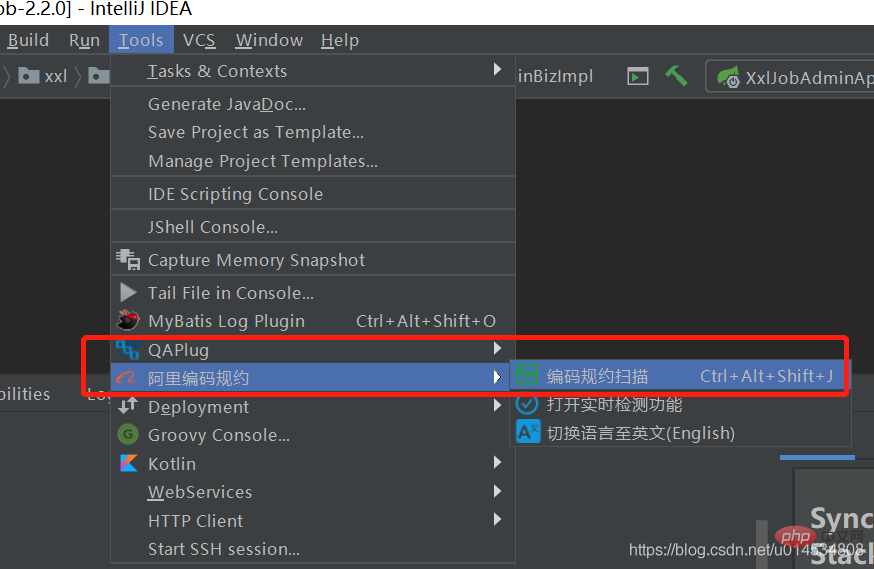
The result of the check is as shown in the figure:
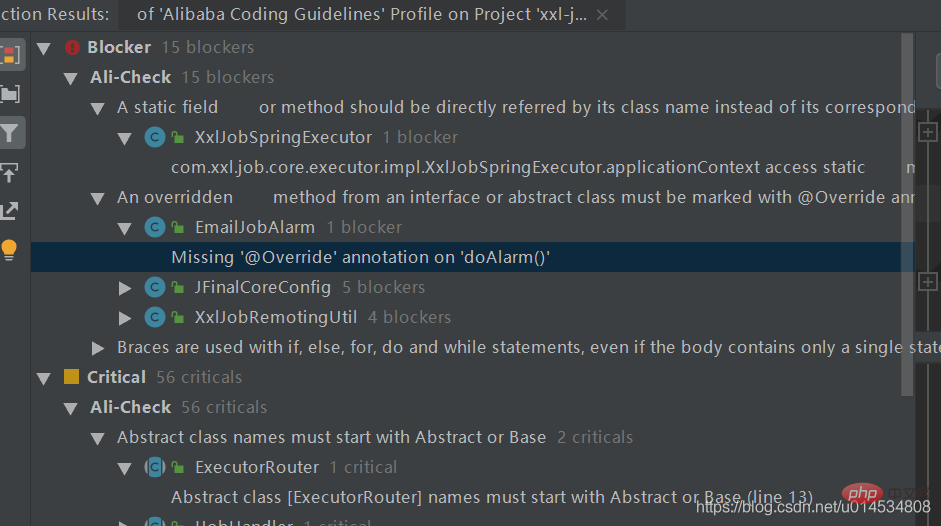
If you want to check a single file, you can right-click on the class , select Alibaba Coding Guidelines Analyze
CheckStyle
The second plug-in to be introduced is the CheckStyle plug-in. This plugin focuses on code format checking. The usage is as follows: In the checkstyle panel, click the check button to check, or you can check a single file.
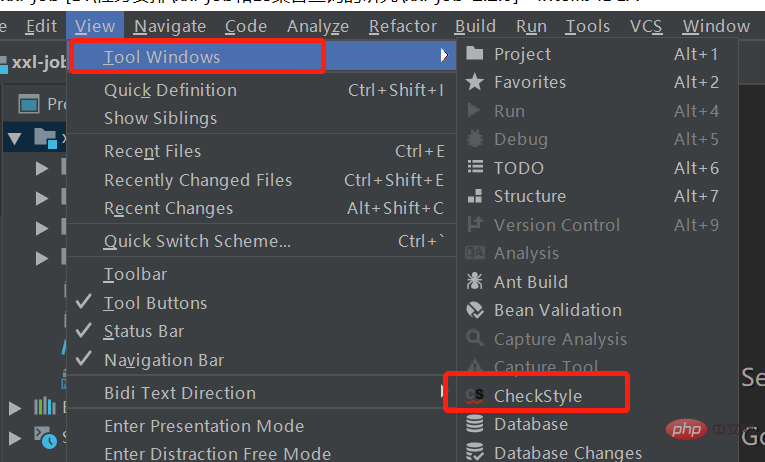
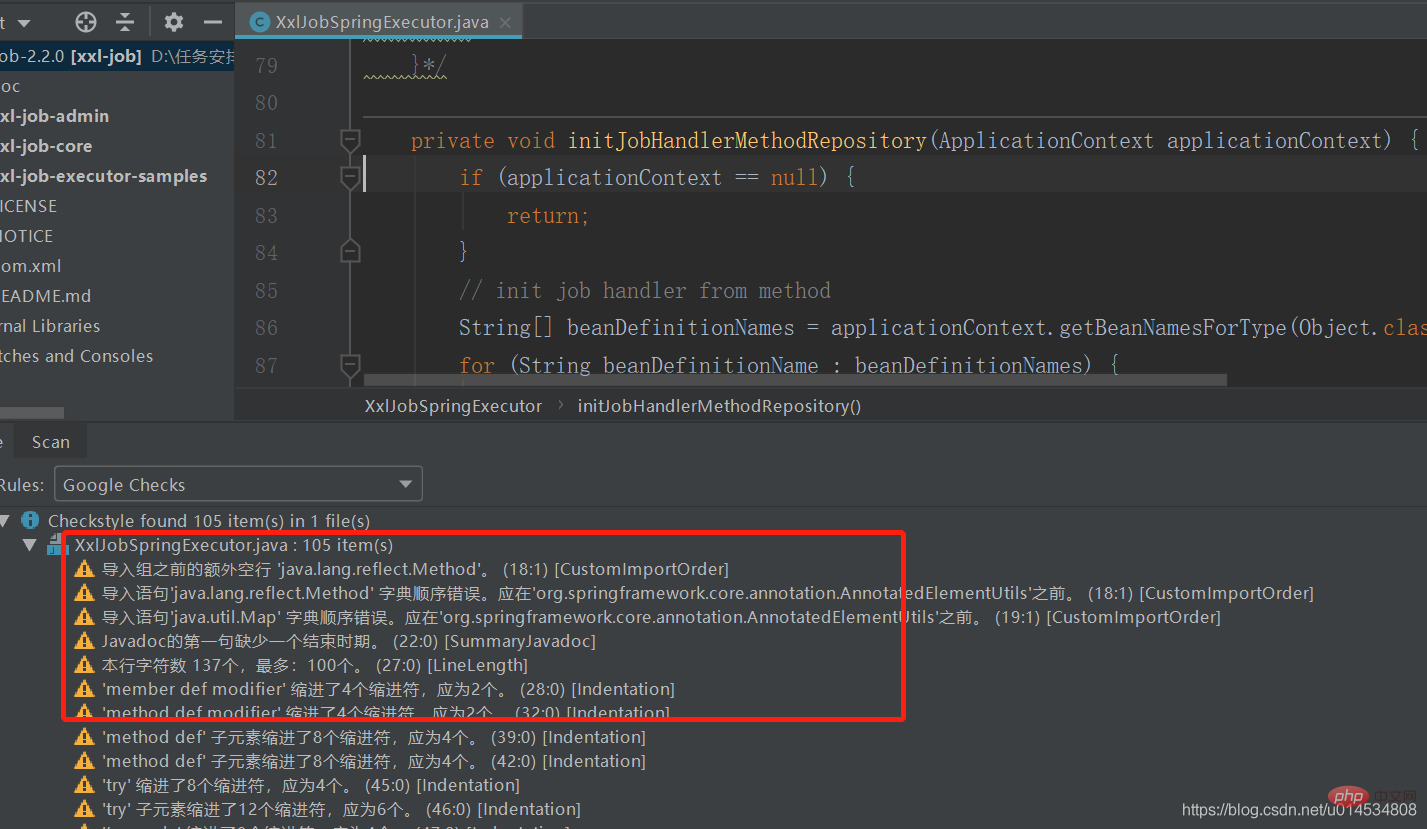
#As shown in the picture above, you can see that there are some coding standards for indentation and so on, so you don’t need to pay too much attention to them.
Findbugs
The function of findBugs-idea focuses on finding bugs that may exist in the code. It inspects a class or JAR file, comparing the bytecode to a set of defect patterns (with built-in detectors) to find possible problems. Execute Findbugs coding convention scanning PMD
(Programming Mistake Detector) is an open source static code inspection tool. PMD supports multiple languages, such as Java for the project itself, Apex and VisualForce related to Salesforce, as well as JavaScript, XML, etc. PMD has a preset set of coding rules for various languages, and also supports the development of custom rules, using Java classes or XPath.
Select a piece of code, and then right-click Run PMD->Pre Defined. There are many inspection types to choose from, including code style, design, etc.
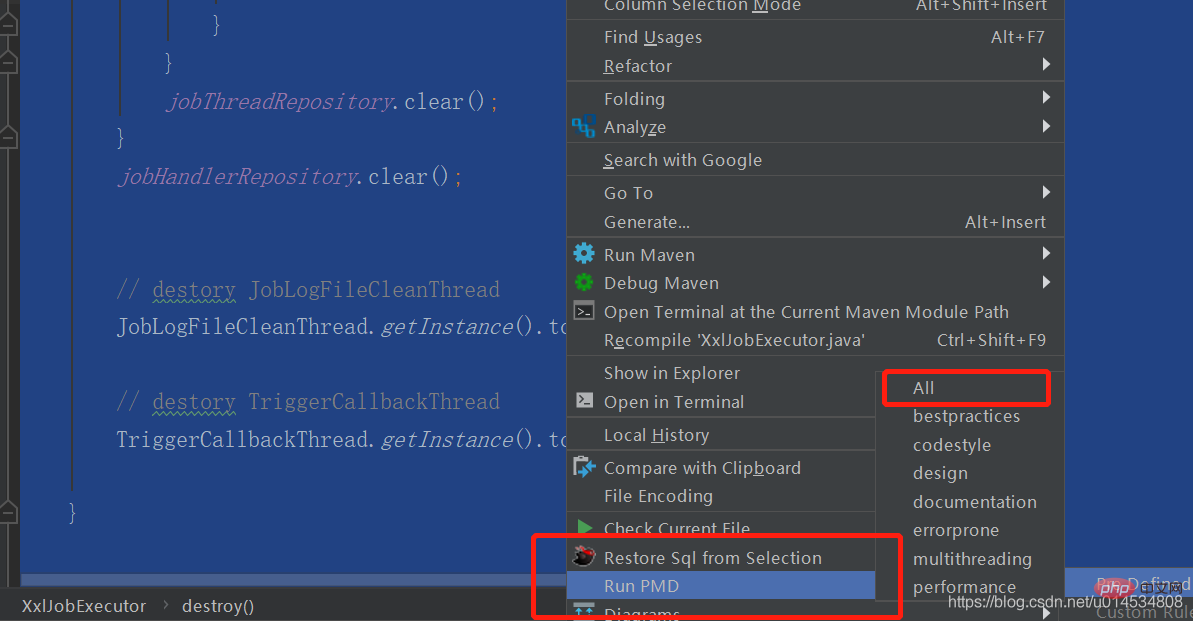
SonarLint
The last thing I want to introduce is the SonarLint plug-in, this plug-in and the Alibaba Java Coding Guidelines plug-in These are two plug-ins that are used more frequently in actual projects. The following will introduce the installation and use of the plug-in in detail.
Installation
settings->plugins里面搜索 SonarLint >install->重啟Idea
Configure SonnarLint check address:
settings->Tools->SonarLint->Settings 中增加sonarqube的地址
Configure the address of sonarqube as shown below
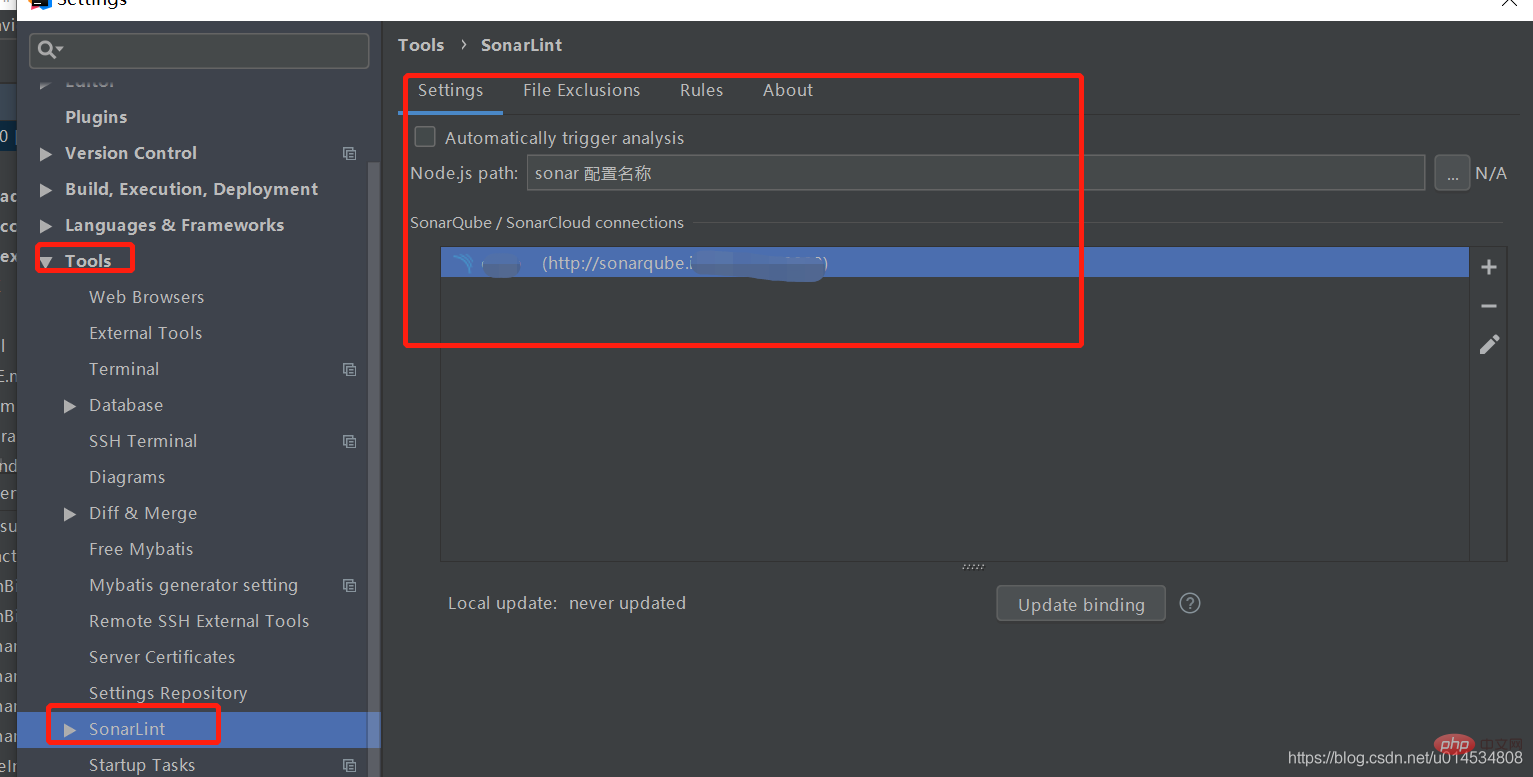
Use SonarList
After configuring SonarList, you can use it. SonarLint can check all files. The way to check all files is: click Analyze->Analyze All Files with SonarLint.
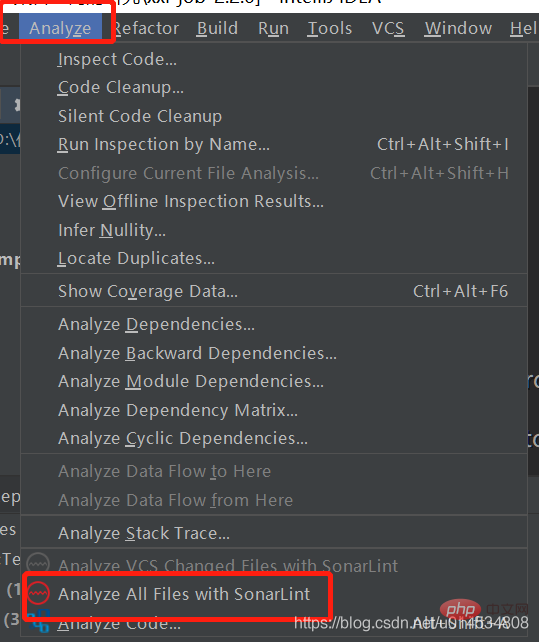
You can also check a single file. A single file is selected by right-clicking in the file editing area:
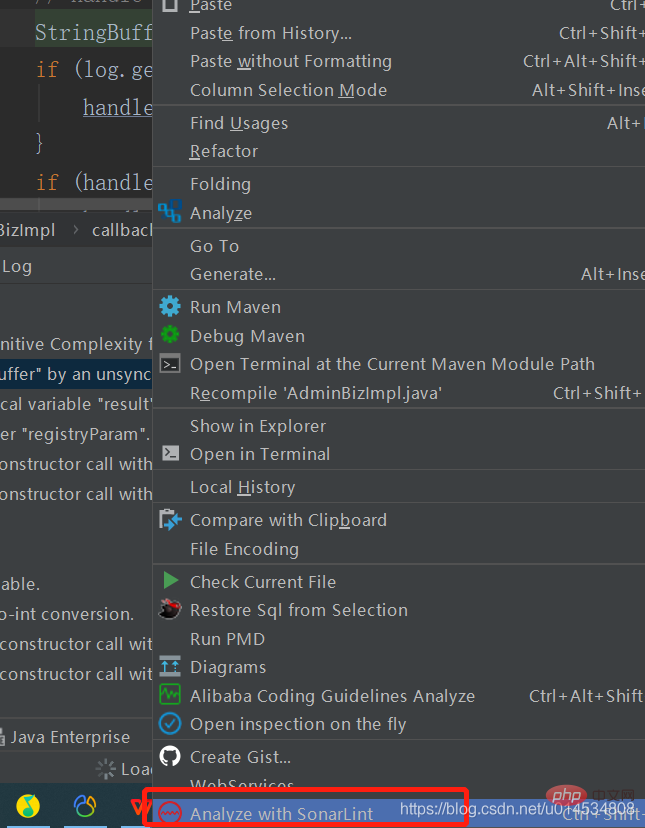
The generated report is as follows : There are both violation issues (ie potential Bugs & Vulnerabilities) here. For example: NullPointerException, which also has bad code smells (Code Smells). Generally speaking, we need to deal with bug-level problems, and bad smells can be ignored. Another indicator is the code duplication rate, that is, the repeated code within the code.

Comparison of various plug-ins
Different focus of inspection
| Tools | Analysis objects | Focus on | Application technology |
|---|---|---|---|
| Alibaba Java Coding Guidelines | Source code | Code defects | Inspection mechanism provides real-time detection function |
| CheckStyle | Source File | Format Defect | Defect Pattern Match |
| FindBugs | Bytecode | Code defects | Defect pattern matching, data flow analysis |
| PMD | Source code | Code defects | Defect pattern matching |
| SonarList | Source code | Code defect | Defect pattern matching, multiple dimensions processing |
Different check items
| Tool | Purpose | Check items |
|---|---|---|
| Alibaba Java Coding Guidelines | Scan out all potential code hazards | Method name parameter name member variable local variable enumeration class try -catch |
| CheckStyle | Check whether the Java source file is consistent with the code specification | Javadoc comment naming specification title import statement volume size blank |
| FindBugs | Based on the concept of Bug Patterns, find potential bugs in javabytecode (.class file) | NullPoint null pointer check, no unreasonable closing of resources |
| PMD | Check Java source files for potential problems | Unused local variables, empty catch blocks, unused parameters, empty if statements, repeated import statements, Unused private methods may be Singleton class short/long variables and method names |
| SonarList | Scan out all potential code hazards | Methods Name parameter name member variable local variable enumeration class try-catch |
Related free learning recommendations: java basic tutorial
The above is the detailed content of How to use coding standards and static code checking plug-ins. For more information, please follow other related articles on the PHP Chinese website!

Hot AI Tools

Undress AI Tool
Undress images for free

Undresser.AI Undress
AI-powered app for creating realistic nude photos

AI Clothes Remover
Online AI tool for removing clothes from photos.

Clothoff.io
AI clothes remover

Video Face Swap
Swap faces in any video effortlessly with our completely free AI face swap tool!

Hot Article

Hot Tools

Notepad++7.3.1
Easy-to-use and free code editor

SublimeText3 Chinese version
Chinese version, very easy to use

Zend Studio 13.0.1
Powerful PHP integrated development environment

Dreamweaver CS6
Visual web development tools

SublimeText3 Mac version
God-level code editing software (SublimeText3)

Hot Topics
 How to iterate over a Map in Java?
Jul 13, 2025 am 02:54 AM
How to iterate over a Map in Java?
Jul 13, 2025 am 02:54 AM
There are three common methods to traverse Map in Java: 1. Use entrySet to obtain keys and values at the same time, which is suitable for most scenarios; 2. Use keySet or values to traverse keys or values respectively; 3. Use Java8's forEach to simplify the code structure. entrySet returns a Set set containing all key-value pairs, and each loop gets the Map.Entry object, suitable for frequent access to keys and values; if only keys or values are required, you can call keySet() or values() respectively, or you can get the value through map.get(key) when traversing the keys; Java 8 can use forEach((key,value)->
 Comparable vs Comparator in Java
Jul 13, 2025 am 02:31 AM
Comparable vs Comparator in Java
Jul 13, 2025 am 02:31 AM
In Java, Comparable is used to define default sorting rules internally, and Comparator is used to define multiple sorting logic externally. 1.Comparable is an interface implemented by the class itself. It defines the natural order by rewriting the compareTo() method. It is suitable for classes with fixed and most commonly used sorting methods, such as String or Integer. 2. Comparator is an externally defined functional interface, implemented through the compare() method, suitable for situations where multiple sorting methods are required for the same class, the class source code cannot be modified, or the sorting logic is often changed. The difference between the two is that Comparable can only define a sorting logic and needs to modify the class itself, while Compar
 How to handle character encoding issues in Java?
Jul 13, 2025 am 02:46 AM
How to handle character encoding issues in Java?
Jul 13, 2025 am 02:46 AM
To deal with character encoding problems in Java, the key is to clearly specify the encoding used at each step. 1. Always specify encoding when reading and writing text, use InputStreamReader and OutputStreamWriter and pass in an explicit character set to avoid relying on system default encoding. 2. Make sure both ends are consistent when processing strings on the network boundary, set the correct Content-Type header and explicitly specify the encoding with the library. 3. Use String.getBytes() and newString(byte[]) with caution, and always manually specify StandardCharsets.UTF_8 to avoid data corruption caused by platform differences. In short, by
 JavaScript Data Types: Primitive vs Reference
Jul 13, 2025 am 02:43 AM
JavaScript Data Types: Primitive vs Reference
Jul 13, 2025 am 02:43 AM
JavaScript data types are divided into primitive types and reference types. Primitive types include string, number, boolean, null, undefined, and symbol. The values are immutable and copies are copied when assigning values, so they do not affect each other; reference types such as objects, arrays and functions store memory addresses, and variables pointing to the same object will affect each other. Typeof and instanceof can be used to determine types, but pay attention to the historical issues of typeofnull. Understanding these two types of differences can help write more stable and reliable code.
 What is the 'static' keyword in Java?
Jul 13, 2025 am 02:51 AM
What is the 'static' keyword in Java?
Jul 13, 2025 am 02:51 AM
InJava,thestatickeywordmeansamemberbelongstotheclassitself,nottoinstances.Staticvariablesaresharedacrossallinstancesandaccessedwithoutobjectcreation,usefulforglobaltrackingorconstants.Staticmethodsoperateattheclasslevel,cannotaccessnon-staticmembers,
 Using std::chrono in C
Jul 15, 2025 am 01:30 AM
Using std::chrono in C
Jul 15, 2025 am 01:30 AM
std::chrono is used in C to process time, including obtaining the current time, measuring execution time, operation time point and duration, and formatting analysis time. 1. Use std::chrono::system_clock::now() to obtain the current time, which can be converted into a readable string, but the system clock may not be monotonous; 2. Use std::chrono::steady_clock to measure the execution time to ensure monotony, and convert it into milliseconds, seconds and other units through duration_cast; 3. Time point (time_point) and duration (duration) can be interoperable, but attention should be paid to unit compatibility and clock epoch (epoch)
 How does a HashMap work internally in Java?
Jul 15, 2025 am 03:10 AM
How does a HashMap work internally in Java?
Jul 15, 2025 am 03:10 AM
HashMap implements key-value pair storage through hash tables in Java, and its core lies in quickly positioning data locations. 1. First use the hashCode() method of the key to generate a hash value and convert it into an array index through bit operations; 2. Different objects may generate the same hash value, resulting in conflicts. At this time, the node is mounted in the form of a linked list. After JDK8, the linked list is too long (default length 8) and it will be converted to a red and black tree to improve efficiency; 3. When using a custom class as a key, the equals() and hashCode() methods must be rewritten; 4. HashMap dynamically expands capacity. When the number of elements exceeds the capacity and multiplies by the load factor (default 0.75), expand and rehash; 5. HashMap is not thread-safe, and Concu should be used in multithreaded
 What is a ReentrantLock in Java?
Jul 13, 2025 am 02:14 AM
What is a ReentrantLock in Java?
Jul 13, 2025 am 02:14 AM
ReentrantLock provides more flexible thread control in Java than synchronized. 1. It supports non-blocking acquisition locks (tryLock()), lock acquisition with timeout (tryLock(longtimeout, TimeUnitunit)) and interruptible wait locks; 2. Allows fair locks to avoid thread hunger; 3. Supports multiple condition variables to achieve a more refined wait/notification mechanism; 4. Need to manually release the lock, unlock() must be called in finally blocks to avoid resource leakage; 5. It is suitable for scenarios that require advanced synchronization control, such as custom synchronization tools or complex concurrent structures, but synchro is still recommended for simple mutual exclusion requirements.






